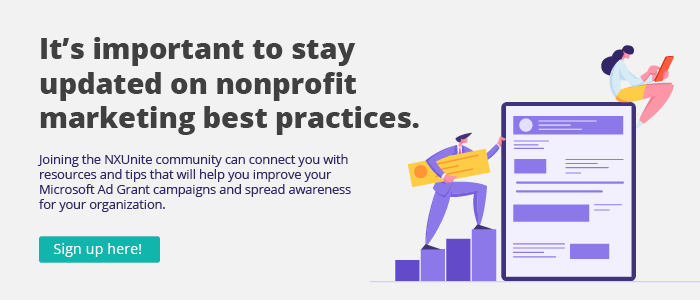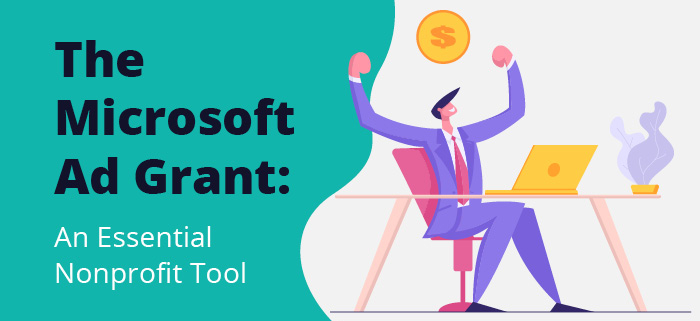The Microsoft Ad Grant: An Essential Nonprofit Tool
If you’ve been in the fundraising world for a while, you might be familiar with the Google Ad Grant program. Google provides eligible nonprofits with $10,000 per month in ad spending to help boost their organizations’ reach online.
However, you may not know much about Microsoft’s new program, Ads for Social Impact, which functions similarly to the Google Ad Grant program. As of June 2022, Microsoft offers nonprofits $3,000 per month in ad spending for platforms such as Bing, Yahoo, AOL, Outlook, MSN, and Microsoft Edge.
Although the grant amounts differ between the two programs, both can help you spread awareness of your organization’s mission and raise money for your cause.
Our mission at NXUnite is to provide nonprofits with tools and resources that will set them up for success. We believe that the Microsoft Ad Grant is one such tool that will help organizations spread their missions and reach their fundraising goals. We’re happy to offer this guide so nonprofits can learn more about the program and how to enroll. Here are the topics we’ll cover:
- Microsoft Ad Grant Basics
- Benefits of Microsoft Ad Grants
- Ways to Use Microsoft Ad Grants
- Eligibility Requirements
- Microsoft Ad Grant Application
- Microsoft Ad Grant Best Practices
- Using Microsoft Ad Grants with Other Fundraising Tools
- Working with a Microsoft Ad Grant Agency
We have a lot to review, so let’s get started!


Microsoft Ad Grant Basics
Microsoft’s Ads for Social Impact program serves to help eligible nonprofits drive traffic to their websites and reach their fundraising and marketing goals at no cost to these organizations. The Microsoft Ad Grant covers $3,000 per month in ad spending for ads on multiple Microsoft-owned websites.
Since Microsoft Ad Grants cover so many different platforms, it can be difficult to picture what an ad created by a participating organization would look like. We’ll walk you through an example on Yahoo so you can visualize how a Microsoft Ad for your particular organization might look.
Let’s say that someone in your community is passionate about protecting wildlife. While checking their Yahoo email, this person might do a quick search for “save the turtles.” Yahoo will return a results page with the phrase “Ads related to: save the turtles” at the top. Underneath, there will be links to websites dedicated to protecting wildlife. These organizations are using Microsoft Ads to boost their reach and spread their mission online.
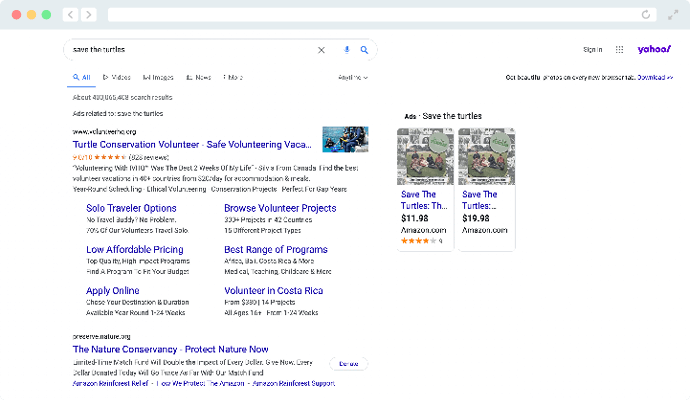
Nonprofits enrolled in the Microsoft Ad Grant program receive unique benefits that distinguish Microsoft’s program from Google’s. Your organization might already leverage paid search opportunities with Google or Microsoft. For nonprofits that use Google Ads, they must create a separate account for the Google Ad Grant program. In contrast, organizations that already use Microsoft Ads can apply their Microsoft Ad Grant directly to their existing account, allowing them to keep all of their campaigns in the same place.
Another difference between the two programs is the required account restrictions. Since Google Ad Grant accounts are separate from typical Google Ad accounts, there are more restrictions put on Google Ad Grant accounts, including minimum click-through rates, minimum quality scores, and maximum cost-per-click. In Microsoft’s program, all of your Microsoft Ads are under one account with none of these restrictions. That way, you can use the grant just as you would use funds for a regular paid search campaign.
Now that we’ve covered the basics, it’s time to move on to the benefits of enrolling in Microsoft’s Ads for Social Impact program.

Benefits of Microsoft Ad Grants
Besides expanding visibility for your website, there are many benefits of leveraging Microsoft Ad Grants. Take a look at some of the main advantages of participating in the program:
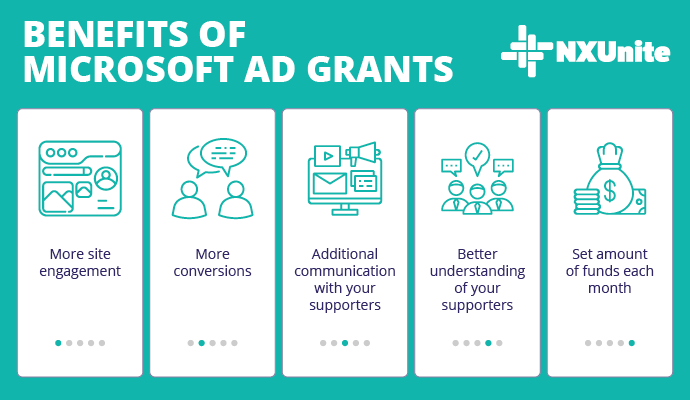
More site engagement.
While creating engaging content is a great way to improve your organization’s website, your content won’t fulfill its purpose if people can’t find your website in the first place.
By producing Microsoft Ads that highlight different pages on your site, you’ll encourage people to check out the resources they’re interested in. Someone looking to volunteer for a nonprofit will search differently than someone looking to donate, and by using your Microsoft Ad Grant appropriately, you can make sure both individuals find the information they need on your website.
More conversions.
Once you get more people to engage with your site, you’re likely to see more conversions. Just as businesses and other for-profit organizations track conversions to sales, nonprofits can track different types of conversions to measure the impact of their campaigns. Some online conversions your organization might track include:
- Donations
- Email list signups
- Event registrations
- Petition signatures
- Ticket sales
- Volunteer signups
By using the Microsoft Ad Grant to show prospective supporters the pages they’re interested in, you can increase the likelihood that people will perform the intended actions associated with those pages rather than aimlessly skimming your website.
Additional communication with your supporters.
As a nonprofit, you likely already use a mix of communication tools such as email, direct mail, phone calls, text messages, and social media. Microsoft Ad Grants provide an additional opportunity to reach out to your supporters in a more understated way.
While it’s important to engage with your supporters in a variety of different ways, it’s also important not to overwhelm them with too much information and too frequent communication. With Microsoft Ad Grants, you allow current and prospective supporters to learn about your organization on their own time and at their own discretion.
Better understanding of your supporters.
When a supporter interacts with your website, their actions provide several types of data for your organization. By keeping track of this data, you can figure out how to improve your campaigns and get the most out of your Microsoft Ad Grant.
To help you analyze your website activity, Microsoft provides tools such as event tracking, campaign analytics, and traffic insights. That way, you can leverage this information and use it to your organization’s advantage to make sure your website and content are serving your supporters as they should.
Set amount of funds each month.
Once you’re enrolled in the Microsoft Ad Grant program, you can be sure that you’ll receive $3,000 in your Microsoft Ad account each month. While this may seem like a given, many traditional grant programs allocate limited grant funds to qualifying organizations based on their needs.
Knowing exactly how much money in ad spending you’ll receive from Microsoft each month, you can better plan how your organization will use the grant without wasting time wondering how much money you’ll be allotted.

Ways to Use Microsoft Ad Grants
Just as it’s important to outline your goals for a fundraiser or social media campaign, it’s good practice to determine what you want to achieve by using your Microsoft Ad Grant. Setting goals for your campaigns will ensure that you’re using your grant money efficiently.
If you’re not sure what goals you’d like to accomplish during your time in the Microsoft Ad Grant program, take a look at some of our suggestions:
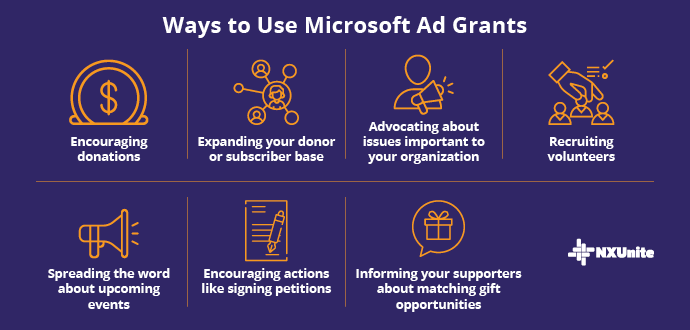
- Encouraging donations
- Expanding your donor or subscriber base
- Advocating about issues important to your organization
- Recruiting volunteers
- Spreading the word about upcoming events
- Encouraging actions like signing petitions
- Informing your supporters about matching gift opportunities
With your goals in mind, you’ll create campaigns with better focus and get the most out of your Microsoft Ad Grant.

Eligibility Requirements
If you’re interested in applying for the Ads for Social Impact program, you’ll need to make sure you’re eligible for the program. Microsoft has three main eligibility requirements. The first is status as a legally recognized nonprofit or non-governmental organization in your country. For United States-based organizations, that includes registering with the IRS as a tax-exempt 501(c)(3) organization.
The next requirement is operating on a not-for-profit basis and serving a specific mission. Microsoft gives mission examples such as helping the poor, preserving the environment, and protecting human rights.
Microsoft’s final requirement is that all participating organizations are inclusive of others. They prohibit any organizations with discriminatory policies or missions from joining the program.
In addition the Microsoft’s three eligibility requirements, they also list ineligible organization types, such as:
- Governmental organizations
- Schools, colleges, and universities
- Healthcare organizations
- Public utilities
- Financial institutions
- Professional, commerce, and trade associations
- Professional and semi-professional sports organizations
- Political, labor, and fraternal organizations
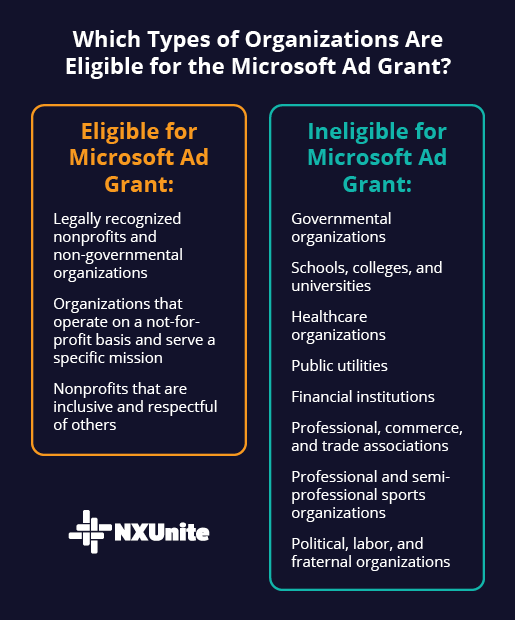
For a full list of eligibility requirements, check out Microsoft’s program eligibility page here.

Microsoft Ad Grant Application
After determining your organization is eligible for the program, the next step is to fill out an application. There are two main parts of the application.
First, you’ll apply to Microsoft for Nonprofits, Microsoft’s overarching program dedicated to nonprofit tools and resources. This part of the application has four steps.
- Welcome & Policies. When you begin the application, you’ll be asked to fill out information for your organization’s point of contact. You’ll also confirm that you understand the Microsoft for Nonprofits program policies.
- Organization Info. In this section, you’ll fill out information about your nonprofit including your organization’s name, address, website, phone number, size, budget, mission statement, and IRS EIN.
- Verify Phone. Next, you’ll verify your organization’s phone number so Microsoft can communicate with you.
- Create Account. Finally, you’ll be able to set up your login for your Microsoft for Nonprofits account. You should hear back about the status of your application within 24 hours.
The second part of the application process is applying for the Microsoft Ad Grant itself. You’ll provide additional information about your nonprofit and point of contact, and Microsoft will get back to you within 10 business days.

Microsoft Ad Grant Best Practices
Once Microsoft accepts your Microsoft Ad Grant application, you’ll likely want to jump right in and start setting up campaigns. To enure your campaigns are effective, we recommend following a few best practices that other nonprofits have found helpful in the past. Here are some guidelines for running your Microsoft Ad Grant account effectively:
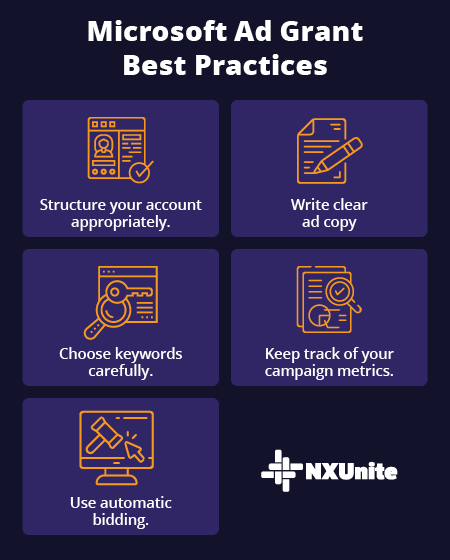
Structure your account appropriately.
Organization is key when it comes to Microsoft Ad Grant campaigns because it allows you to ensure that each campaign has its own specific purpose. The goal of each campaign should be the conversion you’re looking to boost.
For example, let’s say your overall goals for your participation in the program are expanding your email subscriber base, recruiting more volunteers, and informing your supporters about matching gifts. Establish your campaigns’ priorities right away by setting up three separate campaigns, one for each goal. That way, you can track the metrics for each goal separately. Additionally, you can create straightforward campaigns that each focus on one aspect of your mission, making it clear to supporters what you’re asking them to do.
Write clear ad copy.
When it comes to Microsoft Ad copy, the simpler, the better. People will only spend a few seconds looking at your ad, so you want to make sure your message is very clear. Short sentences are usually best. It’s also good practice to avoid uncommon acronyms or abbreviations that may confuse people.
Choose keywords carefully.
To make sure you’re choosing effective keywords, you’ll want to think backward. What are your supporters likely searching for? Those are the words and phrases you’ll want to choose as your keywords.
It’s best to choose specific keywords. People searching for “animals” aren’t necessarily looking for an animal shelter, but those searching for “volunteering with animals” or “adopting a pet” might be.
Keep track of your campaign metrics.
Luckily, Microsoft has built-in analytics options that allow you to easily track the success of your campaigns. Analyzing this data and implementing the insights you glean from it will allow you to shape your campaigns and content to your supporters’ needs.
For example, if you see that people are going straight from your volunteer registration page to your contact information page, it might be useful to add a section with contact information on the volunteer registration page itself for easy access.
Use automatic bidding.
In order to show up in searches for certain keywords, you’ll bid for them along with other organizations. You can submit bids manually, but Microsoft has automatic bidding options that will save your team time and energy.
These bidding strategies include ones for enhancing your cost-per-click, maximizing your clicks, maximizing your conversions, and achieving your target cost per acquisition and return on ad spend.
Following these best practices will ensure that you’re managing your campaigns efficiently and effectively.

Using Microsoft Ad Grants with Other Fundraising Tools
At NXUnite, we’re passionate about connecting nonprofits with the tools and resources that will launch them toward success. While Microsoft Ad Grants are one such tool, leveraging a variety of tools and strategies will help your organization spread awareness and raise money for its cause. Take a look at how your organization can use Microsoft Ad Grants in conjunction with other valuable fundraising tools:
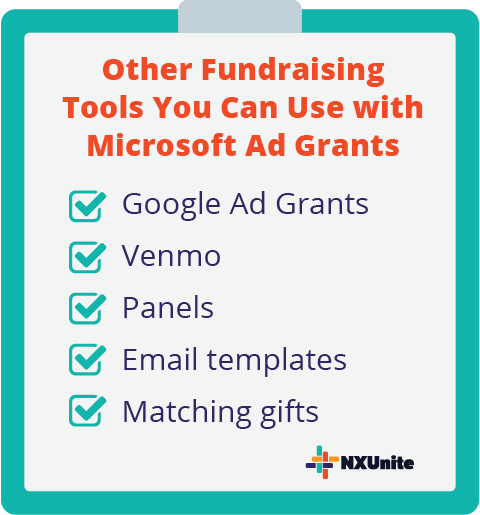
- Google Ad Grants. While we’ve compared the Microsoft Ads for Social Impact program and the Google Ad Grant program, your organization can take advantage of both for maximum impact. You can create similar campaigns on both platforms so that people can find your organization on both Microsoft and Google search engines.
- Venmo. Many people use personal Venmo accounts, but you can also set up an account for your organization. That way, people can easily donate to your nonprofit. To promote your organization’s Venmo account, create a Microsoft Ad Grant campaign linking to your donation page. Then, include Venmo as a donation option on the page.
- Panels. Attending panels is a great way to learn more about nonprofit resources from experts and professionals. This wisdom you acquire from these discussions may spark inspiration for a new campaign or approach to your Microsoft Ad Grant account.
- Email templates. No matter your campaign goals, you’re likely encouraging your supporters to take some sort of action on your website. To show your appreciation, it’s always a good idea to send a thank-you letter. Using a specific nonprofit email template can ensure that you thank your supporters appropriately.
- Matching gifts. If you’re really looking to maximize your fundraising, you can use your Microsoft Ad Grant campaign to inform your supporters about matching gifts. Matching gifts are corporate philanthropy initiatives where employers double or even triple donations made by their employees. All your supporters have to do is notify their employers of their donation. There are plenty of tools that make that process extremely simple.
Knowing which nonprofit tools are available for you to use is important, but knowing how to use them in conjunction with each other is even more powerful.

Working with a Microsoft Ad Grant Agency
While we hope this guide will help you manage your Microsoft Ad Grant effectively, we also understand that many nonprofits have constrained time and energy to devote to new projects. That’s where digital marketing agencies come in.
There are organizations out there that are specifically dedicated to helping nonprofits manage ad grants. They know the ins and outs of different ad grant programs and how to optimize your account. These types of agencies can help with any stage of the grant management process, such as:
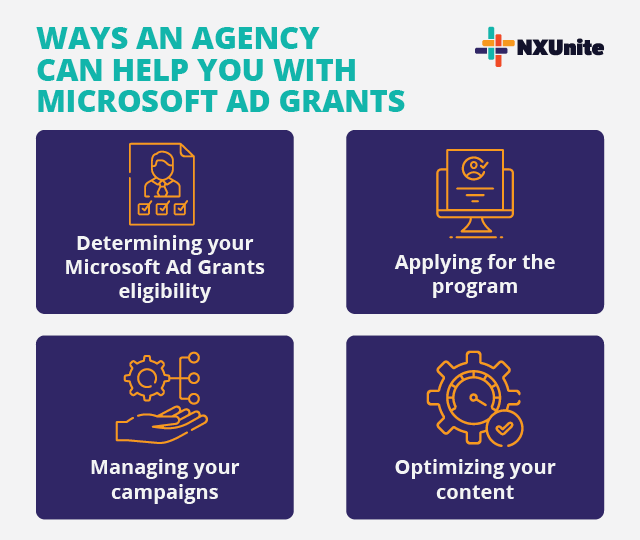
- Determining your Microsoft Ad Grants eligibility
- Applying for the program
- Managing your campaigns
- Optimizing your content
Reaching out to a digital marketing agency can take the burden of managing your ad grant off your team. You can feel at ease knowing that experts are taking care of your account.

More Fundraising Tools
By now, you should understand what the Microsoft Ad Grant is and how powerful of a fundraising tool it truly is. By enrolling in the Microsoft Ad Grant program, you’ll be able to work toward your organization’s fundraising goals and raise awareness for your cause.
As we mentioned, there are many other great fundraising tools out there. These articles will allow you to learn more about some of the ones we recommend:
- How Google Ad Grants Can Help Your Fundraising. In this article, you’ll learn more about the Google Ad Grant program, allowing you to compare it to Microsoft’s program. Better yet, you can take advantage of both programs and the benefits they have to offer.
- How Venmo for Nonprofits Can Help Organizations Raise More. Venmo is not only a personal mobile payment service, but nonprofits can also leverage the platform to collect donations. This article walks through how nonprofits can use this tool to boost their fundraising efforts.
- Donor Thank-You Letters. Most likely, one of your campaign goals is to increase donations. Thank your donors for contributing to your organization using one of these templates.
